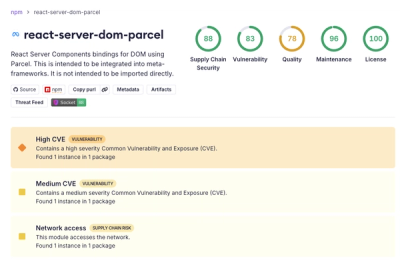
Security News
Deno 2.6 + Socket: Supply Chain Defense In Your CLI
Deno 2.6 introduces deno audit with a new --socket flag that plugs directly into Socket to bring supply chain security checks into the Deno CLI.
databricks-cli
Advanced tools
Note
Databricks recommends that you use newer Databricks CLI versions 0.200 and above instead of legacy Databricks CLI versions 0.17 and below (located in this repository). You can find the new CLI at https://github.com/databricks/cli.
If you have been using the code in this repository as a Python SDK for interacting with the Databricks APIs, we recommend you use the new dedicated SDK package that can be found at https://github.com/databricks/databricks-sdk-py.
.. image:: https://github.com/databricks/databricks-cli/actions/workflows/push.yml/badge.svg?branch=main :target: https://github.com/databricks/databricks-cli/actions/workflows/push.yml?query=branch%main :alt: Build status .. image:: https://codecov.io/gh/databricks/databricks-cli/branch/main/graph/badge.svg :target: https://codecov.io/gh/databricks/databricks-cli
The Databricks Command Line Interface (CLI) is an open source tool which provides an easy to use interface to the Databricks platform. The CLI is built on top of the Databricks REST APIs.
Note: This CLI is no longer under active development and has been released as an experimental client.
Please leave bug reports as issues on our GitHub project <https://github.com/databricks/databricks-cli>_.
To install simply run
pip install --upgrade databricks-cli
Then set up authentication using username/password or authentication token <https://docs.databricks.com/api/latest/authentication.html#token-management>_. Credentials are stored at ~/.databrickscfg.
databricks configure (enter hostname/username/password at prompt)databricks configure --token (enter hostname/auth-token at prompt)Multiple connection profiles are also supported with databricks configure --profile <profile> [--token].
The connection profile can be used as such: databricks workspace ls --profile <profile>.
To test that your authentication information is working, try a quick test like databricks workspace ls.
AttributeError: 'module' object has no attribute 'PROTOCOL_TLSv1_2'
The Databricks web service requires clients speak TLSV1.2. The built in version of Python for MacOS does not have this version of TLS built in.
To use the Databricks CLI you must install a version of Python that has ssl.PROTOCOL_TLSv1_2.
For MacOS, the easiest way may be to install Python with Homebrew <https://brew.sh/>_.
.. code::
# build image
docker build -t databricks-cli .
# run container
docker run -it databricks-cli
# run command in docker
docker run -it databricks-cli fs --help
For the latest CLI documentation, see
Databricks <https://docs.databricks.com/user-guide/dev-tools/databricks-cli.html>_Azure Databricks <https://learn.microsoft.com/en-us/azure/databricks/dev-tools/cli>_FAQs
A command line interface for Databricks
We found that databricks-cli demonstrated a healthy version release cadence and project activity because the last version was released less than a year ago. It has 2 open source maintainers collaborating on the project.
Did you know?

Socket for GitHub automatically highlights issues in each pull request and monitors the health of all your open source dependencies. Discover the contents of your packages and block harmful activity before you install or update your dependencies.

Security News
Deno 2.6 introduces deno audit with a new --socket flag that plugs directly into Socket to bring supply chain security checks into the Deno CLI.

Security News
New DoS and source code exposure bugs in React Server Components and Next.js: what’s affected and how to update safely.

Security News
Socket CEO Feross Aboukhadijeh joins Software Engineering Daily to discuss modern software supply chain attacks and rising AI-driven security risks.